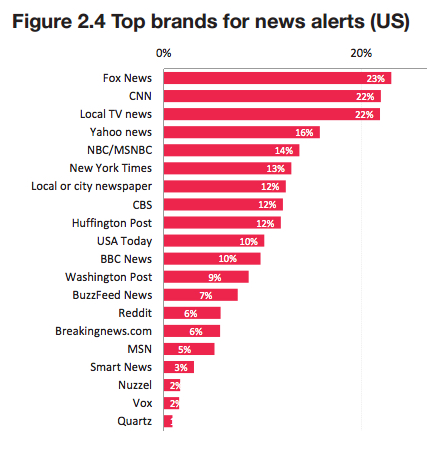How many news alerts will you tolerate on your smartphone’s lockscreen? Which organizations do you get them from? And what types of alerts do you prefer?
“News Alerts and the Battle for the Lockscreen, a new report by Nic Newman for the Reuters Institute for the Study of Journalism, surveyed 7,577 adults in the U.S., U.K., Germany, and Taiwan who received notifications from news apps on their phones and said they engaged with the notifications frequently.
Among the survey’s findings:
— A third of smartphone users in America receive news alerts; of those, 72 percent “say they value the notifications they receive and many see alerts as a critical part of the news app proposition.”— Breaking news alerts were the type most valued by users. “Clickbait headline and emojis were strongly disliked in this context…People click on the alert about half the time.”
— Fox, CNN, and (surprise?) local TV news were the top U.S. brands for those who received news/sports alerts. Meanwhile, BBC News was by far the top source of news alerts in the U.K. (63 percent); the top brand in Germany was TV company n-tv; and Yahoo News was the most popular source in Taiwan, followed by Apple News.

Newman notes that “there is clearly a significant demand for personalized and targeted alerts,” but this is challenging, because it requires “a deep understanding of audiences, along with investment in technical solutions that learn about individual preferences based on usage and other signals. This will be important because most users, particularly older groups, tend not to make or change selections manually.”
Right in the middle of @nicnewman's webinar talking about app users hating irrelevant news alerts, up pops this one from NYT pic.twitter.com/SVwP3zXWzy
— Subhajit Banerjee (@subhajitb) December 1, 2016
@palafo @jacqui @nicnewman @cochranism Is that a failing of users or of the app? And I honestly can't find a way to change that in settings
— Subhajit Banerjee (@subhajitb) December 1, 2016
News organizations are working on this: The New York Times lets users separate out the kinds of alerts they get, for instance. “We’re mindful of the fact that it may irritate our readers when they get alerts about things that aren’t breaking news,” the Times’ Karron Skog told Nieman Lab last year.
The full report is here.